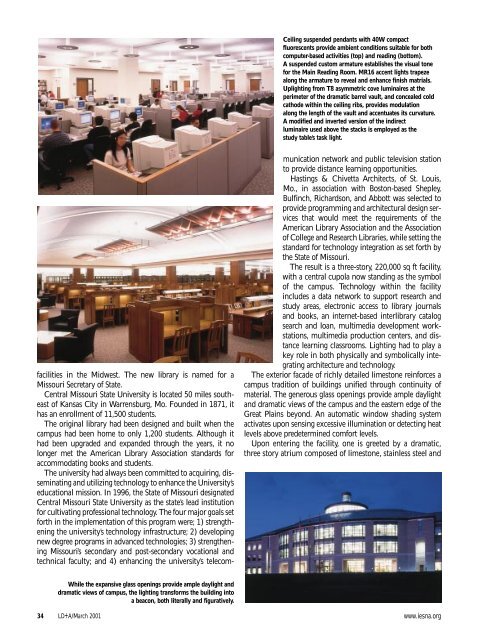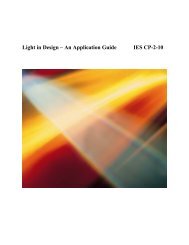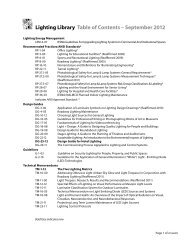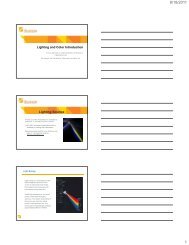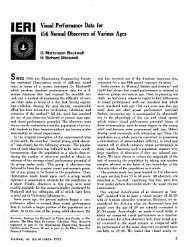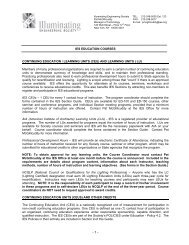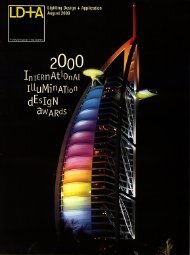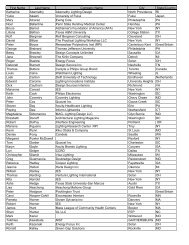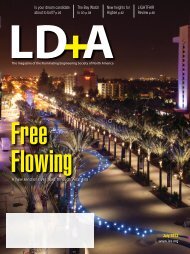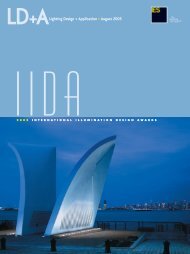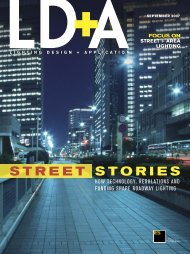contents - Illuminating Engineering Society
contents - Illuminating Engineering Society
contents - Illuminating Engineering Society
You also want an ePaper? Increase the reach of your titles
YUMPU automatically turns print PDFs into web optimized ePapers that Google loves.
Ceiling suspended pendants with 40W compact<br />
fluorescents provide ambient conditions suitable for both<br />
computer-based activities (top) and reading (bottom).<br />
A suspended custom armature establishes the visual tone<br />
for the Main Reading Room. MR16 accent lights trapeze<br />
along the armature to reveal and enhance finish matrials.<br />
Uplighting from T8 asymmetric cove luminaires at the<br />
perimeter of the dramatic barrel vault, and concealed cold<br />
cathode within the ceiling ribs, provides modulation<br />
along the length of the vault and accentuates its curvature.<br />
A modified and inverted version of the indirect<br />
luminaire used above the stacks is employed as the<br />
study table’s task light.<br />
facilities in the Midwest. The new library is named for a<br />
Missouri Secretary of State.<br />
Central Missouri State University is located 50 miles southeast<br />
of Kansas City in Warrensburg, Mo. Founded in 1871, it<br />
has an enrollment of 11,500 students.<br />
The original library had been designed and built when the<br />
campus had been home to only 1,200 students. Although it<br />
had been upgraded and expanded through the years, it no<br />
longer met the American Library Association standards for<br />
accommodating books and students.<br />
The university had always been committed to acquiring, disseminating<br />
and utilizing technology to enhance the University’s<br />
educational mission. In 1996, the State of Missouri designated<br />
Central Missouri State University as the state’s lead institution<br />
for cultivating professional technology. The four major goals set<br />
forth in the implementation of this program were; 1) strengthening<br />
the university’s technology infrastructure; 2) developing<br />
new degree programs in advanced technologies; 3) strengthening<br />
Missouri’s secondary and post-secondary vocational and<br />
technical faculty; and 4) enhancing the university’s telecommunication<br />
network and public television station<br />
to provide distance learning opportunities.<br />
Hastings & Chivetta Architects, of St. Louis,<br />
Mo., in association with Boston-based Shepley,<br />
Bulfinch, Richardson, and Abbott was selected to<br />
provide programming and architectural design services<br />
that would meet the requirements of the<br />
American Library Association and the Association<br />
of College and Research Libraries, while setting the<br />
standard for technology integration as set forth by<br />
the State of Missouri.<br />
The result is a three-story, 220,000 sq ft facility,<br />
with a central cupola now standing as the symbol<br />
of the campus. Technology within the facility<br />
includes a data network to support research and<br />
study areas, electronic access to library journals<br />
and books, an internet-based interlibrary catalog<br />
search and loan, multimedia development workstations,<br />
multimedia production centers, and distance<br />
learning classrooms. Lighting had to play a<br />
key role in both physically and symbolically integrating<br />
architecture and technology.<br />
The exterior facade of richly detailed limestone reinforces a<br />
campus tradition of buildings unified through continuity of<br />
material. The generous glass openings provide ample daylight<br />
and dramatic views of the campus and the eastern edge of the<br />
Great Plains beyond. An automatic window shading system<br />
activates upon sensing excessive illumination or detecting heat<br />
levels above predetermined comfort levels.<br />
Upon entering the facility, one is greeted by a dramatic,<br />
three story atrium composed of limestone, stainless steel and<br />
While the expansive glass openings provide ample daylight and<br />
dramatic views of campus, the lighting transforms the building into<br />
a beacon, both literally and figuratively.<br />
34 LD+A/March 2001 www.iesna.org


